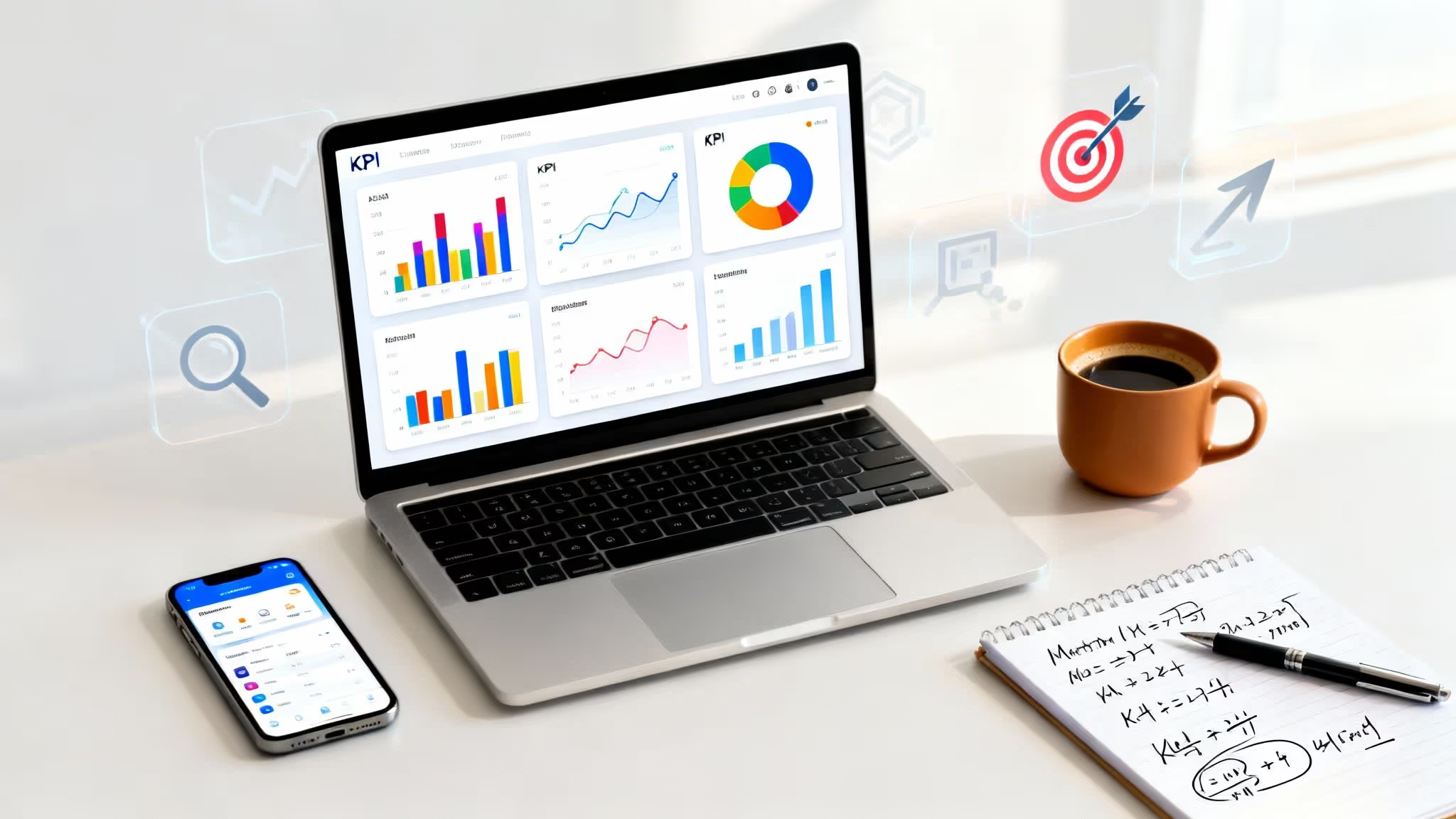For a SaaS company, effective SEO isn't just about climbing search rankings; it's about building a customer acquisition machine that brings in qualified leads 24/7. Think of it this way: paid advertising is like renting an audience—the leads stop the second you turn off the money. A solid SEO strategy, on the other hand, is a compounding asset that grows in value over time, driving scalable and sustainable growth in a crowded market.
Why SEO Is Your Most Powerful Growth Channel

Picture your ideal customer. They have a problem, and your software is the solution. Right now, they're typing that problem into Google. SEO is how you ensure your website shows up at that exact moment of need. It’s not about attracting any traffic; it’s about attracting the right traffic—people actively seeking a solution and ready to convert.
This approach perfectly fits the unique SaaS sales cycle, where prospects need education and trust before making a purchase. A smart SEO plan builds that trust with genuinely helpful content, piece by piece.
The Compounding Value of Organic Search
Unlike paid ads, where costs constantly rise, SEO is an investment that pays increasing dividends. An authoritative blog post published today can generate high-quality leads for years. This creates a "flywheel effect," where each new piece of content adds momentum, strengthening your site's overall authority and visibility.
This long-term value naturally leads to a much lower customer acquisition cost (CAC). Here's why:
- Brand Authority: Consistently appearing for key industry terms establishes you as the go-to expert.
- Qualified Leads: SEO attracts people actively searching for your solution, resulting in higher conversion rates.
- Sustainable Growth: It provides a steady, predictable flow of organic leads, reducing dependency on volatile ad platforms.
SEO delivers incredibly high returns for B2B SaaS companies. The average SEO ROI is a staggering 702%, meaning for every dollar spent, SaaS businesses get back $7.02. On average, it takes only about seven months to break even.
Moving Beyond Paid Channels
Relying solely on paid ads is a precarious strategy. As competition increases, ad costs soar and profit margins shrink. SEO offers a powerful alternative by helping you build an owned marketing channel that you control. It’s not just another marketing tactic; it’s a core business asset.
To fully grasp its impact, it's helpful to understand what makes this channel so effective. Our guide on whether SEO is worth it breaks down the core arguments. Ultimately, investing in SEO for SaaS companies is an investment in predictable, scalable, and profitable growth.
How to Master SaaS Keyword Research
Solid SEO for any SaaS company is built on understanding what potential customers are actually searching for. This goes beyond plugging ideas into a keyword tool; it's about getting inside your customer's head and mapping their entire journey—from problem discovery to solution purchase.
Without this crucial step, you're essentially creating content in the dark.
The key is to focus on user intent. What problem are they trying to solve right now? Are they just beginning their research? Comparing different tools? Or are they ready to buy? Each stage requires a different type of keyword and a unique content approach.

A Funnel-Based Keyword Strategy
To structure your research, use the classic marketing funnel. This model is perfect for categorizing keywords based on a person's proximity to purchasing, ensuring you create the right content to meet them exactly where they are.
As people move from "Problem-Aware" to "Product-Aware," their searches become more specific and carry higher commercial intent. You're not just attracting traffic; you're guiding prospects toward a solution.
Let’s explore how to organize your keyword research to align with the customer’s journey, from their initial problem to their final purchase decision.
By mapping keywords and content to each stage, you create a complete ecosystem that systematically converts curious searchers into paying customers.
Uncovering and Prioritizing Keywords
Now that you understand the funnel, where do you find the keywords?
Start by brainstorming the core problems your software solves. Think like your ideal customer: What would they type into Google when frustrated, curious, or ready to buy? Use tools like Ahrefs or Semrush to analyze search volume and competition, but let customer insight guide your strategy.
Next, analyze your competitors. What keywords drive their best organic traffic? Identify "keyword gaps"—terms they rank for that you don't. This can reveal untapped opportunities to reach qualified leads.
It's also crucial to group related keywords into topic clusters. This strategy helps build topical authority in Google's eyes. You can learn more about keyword clusters and how to use them to make your content efforts more effective.
When choosing your targets, prioritize keywords that balance relevance, search volume, and commercial intent. A high-volume term like "productivity tips" is tempting, but a lower-volume, high-intent keyword like "acme project tool integration with slack" is far more valuable because it captures a near-perfect customer. This targeted approach is the heart of great SEO for SaaS companies.
Building Your SaaS Content Engine
All the technical SEO in the world won't matter if your website is a ghost town. Effective SEO for SaaS companies is fueled by high-quality, strategic content. Think of your website as a high-performance engine; without the right fuel, it goes nowhere. Your content is that high-octane fuel, driving traffic, building authority, and powering conversions.
The goal isn't just to publish a blog post every week. It's about building a strategic library of resources that cements your brand as the definitive expert in your industry. This requires moving beyond random topics and adopting an intentional framework.
Adopting the Topic Cluster Model
One of the most powerful frameworks for SaaS is the topic cluster model. Instead of targeting individual keywords with disconnected articles, you build deep authority around a central theme, creating the definitive digital resource for a core problem your software solves.
This model has two key components:
- Pillar Page: A long-form, comprehensive guide covering a broad topic your audience cares about. For a project management tool, a pillar page might be "The Ultimate Guide to Agile Project Management."
- Cluster Content: Shorter, focused articles that explore specific sub-topics and link back to your pillar page. Examples include "Top 5 Agile Sprint Planning Tools" or "How to Run an Effective Daily Scrum Meeting."
This structure signals deep expertise to Google. Each cluster article reinforces the authority of the pillar page, creating a powerful internal linking web that can boost rankings across the board.
Building a strong content engine is no longer optional. Companies that embrace content marketing and SEO experience growth rates approximately 30% higher than those that don't, providing a clear competitive advantage.
Must-Have Content Types for Every SaaS Company
Beyond standard blog posts, certain content types are invaluable for attracting and converting SaaS customers. These formats capture users at the critical moment of their buying decision.
Focus your efforts on these high-impact formats:
- Comparison Pages ('VS' Articles): When someone searches "[Your Brand] vs [Competitor Brand]," they are close to purchasing. A dedicated, honest comparison page lets you control the narrative and highlight your unique strengths.
- Competitor Alternative Pages: Keywords like "[Competitor] alternatives" are a gift. They come from users who are dissatisfied with another solution and actively seeking a new one. This allows you to position your product as the ideal alternative by addressing their specific pain points.
- Use-Case and Feature-Driven Posts: These articles bridge the gap between a prospect's problem and your product's solution. A title like "How to Automate Team Reporting with [Your Feature Name]" is powerful because it solves a specific user need while demonstrating your tool's value.
The SaaS space is crowded, and a robust content strategy is how you stand out. A staggering 80% of business decision-makers prefer to get information from educational articles rather than advertisements. You can find more stats like this over at UserGuiding.com.
This proves that content-driven SEO is the most effective way to attract high-intent prospects during their research phase. By building this content engine, you're not just chasing rankings; you're creating a scalable, long-term asset that guides prospects from searchers to loyal customers.
The Technical SEO Your SaaS Website Can't Ignore

You've built incredible software and crafted amazing content, but none of it matters if search engines can't properly crawl, understand, and index your website. This is where technical SEO comes in—it’s the solid foundation that supports all your marketing efforts.
Think of your website as a high-performance car. Your content is the fuel, but technical SEO is the engine. Without a well-tuned engine, that premium fuel is wasted. The same principle applies to SEO for SaaS companies; a technically sound site unleashes the full potential of every piece of content you create.
This comes down to the core experience for both search engine bots and human visitors. Your homepage, pricing page, and feature pages must load quickly, function flawlessly on mobile, and be easy to navigate. A slow or confusing site frustrates users and signals to Google that your page isn't a high-quality result.
Core Technical Optimizations for SaaS
Getting the fundamentals right is non-negotiable. In today's competitive landscape, a fast, secure, and well-structured site is table stakes.
Here are the essential optimizations:
- Site Speed and Core Web Vitals: Every millisecond counts. A slow-loading pricing page can be the difference between a new trial sign-up and a lost customer. Optimize images, reduce server response times, and streamline your code. Dive deeper with our guide on what Core Web Vitals are and why they matter.
- A Mobile-First Experience: The majority of your traffic likely comes from mobile devices. Your website must deliver a flawless experience on a smartphone, from browsing features to signing up for a demo. This isn't optional—Google primarily uses the mobile version of a site for indexing and ranking.
- Logical Internal Linking: A smart internal linking structure acts as a GPS for search engines, guiding them to your most important pages. It distributes authority throughout your site and shows Google how your content is interconnected, reinforcing your topical expertise.
Advanced Technical SEO for a Competitive Edge
Once your foundation is solid, you can employ advanced tactics to stand out in search results and provide richer information to Google.
Technical health is a continuous effort, not a one-time project. Over 66% of backlinks are broken, which can damage a site's authority. With nearly 88% of websites now using HTTPS—a known ranking factor—security is essential for building trust and climbing the ranks.
For SaaS companies, one of the most powerful tools is structured data, specifically SoftwareApp schema. This code snippet helps search engines understand that your page is about a software application, unlocking rich results like ratings, price, and operating system information directly in the search listings.
Surprisingly, almost 23% of websites use no structured data at all. This presents a massive opportunity to gain a competitive advantage. To see how these factors fit into the bigger picture, check out the latest SaaS content marketing statistics.
By pairing a solid technical foundation with these advanced optimizations, you ensure your website becomes a powerful, reliable engine driving your content marketing and lead generation efforts.
Earning Links and Building Authority
Let's address the final piece of the puzzle: authority. You can have amazing content and a perfectly tuned website, but to truly climb the search rankings, you need to show Google you're a trusted voice in your industry.
In SEO, authority is primarily built through backlinks—links from other websites pointing to yours. Think of each high-quality backlink as a vote of confidence. It’s another site telling Google, "This content is valuable and trustworthy."
Effective SEO for SaaS companies is about earning these votes legitimately. Forget outdated tactics like spamming guest posts on low-quality blogs. Today, success comes from creating assets that others want to link to because they're genuinely useful, insightful, or newsworthy. This approach not only improves rankings but also drives valuable referral traffic.
Create Link-Worthy Assets Through Digital PR
One of the most effective ways to earn high-quality links at scale is through digital PR. This involves creating unique, data-driven content that journalists, bloggers, and industry publications are excited to feature and cite.
Instead of another standard blog post, think bigger. Create assets that are inherently shareable, such as:
- Original Research Reports: Survey your customer base to uncover fresh trends and statistics in your niche. Package the findings into a polished report that offers unique insights.
- Data-Driven Studies: Your platform is a goldmine of anonymous usage data. A project management tool, for example, could publish a study on the most productive days for remote teams. This is a story reporters will want to cover.
- Free Tools or Calculators: Build a simple, useful tool that solves a common problem for your ideal customer. These are natural link magnets because they provide immediate value.
When you create something genuinely newsworthy, outreach becomes far more effective. You're not just asking for a link—you're offering valuable data to enhance their own content.
Leverage Partnerships and Industry Mentions
Many SaaS companies overlook a goldmine of link opportunities: their existing business relationships. Start with your integration partners. If your tool connects with another platform, you have a built-in co-marketing opportunity. Co-author a blog post, host a joint webinar, or get your logo (and a link) on their integrations page.
A strong backlink profile isn't just a collection of links. It's about weaving a web of trust around your brand. Each link from a reputable source reinforces your expertise and tells search engines you're an authority worth ranking.
Another excellent tactic is using services like Help a Reporter Out (HARO). Journalists and bloggers constantly seek expert quotes for their articles. By providing a sharp, insightful response to a relevant query, you can land mentions and links from major publications and key industry blogs. It’s a direct way to position your team as experts while building your site's authority.
If you're looking to build a stronger foundation, our essential guide to link building dives into even more strategies.
Measuring the ROI of Your SaaS SEO
You've put in the work, and your traffic is climbing. That's great, but it's only half the story. The final and most critical step in any successful SEO strategy is proving that your efforts are actually growing the business.
Stakeholders aren't swayed by vanity metrics alone. They want to see how organic search connects directly to the bottom line. This means shifting the conversation from traffic and rankings to the SaaS KPIs that truly matter.
Connecting SEO to Business Outcomes
For SaaS companies, effective SEO is measured by its impact on revenue. It’s not enough to report that you rank for a keyword; you must show that the keyword drives trial sign-ups, demo requests, and new monthly recurring revenue (MRR). This is how you demonstrate a tangible return on investment.
To do this, you'll need to master tools like Google Analytics 4 (GA4) and Google Search Console. These platforms allow you to connect the dots between organic visibility and customer conversions, painting a clear picture of what's working.
The key is proper conversion tracking. You need to focus on the high-value actions that signal a qualified lead, such as:
- Free Trial Sign-ups: How many users who found you via organic search started a trial?
- Demo Requests: Which search terms are leading people to complete your demo form?
- Pricing Page Visits: Monitoring traffic to this page is a powerful indicator of serious buying intent.
This dashboard is a perfect example of how you can visualize what matters, connecting traffic sources directly to conversions and revenue.
When you track these bottom-of-funnel conversions, you can confidently attribute new customers and revenue directly back to your SEO efforts.
The ultimate goal is to move the conversation from "How much traffic are we getting?" to "How much revenue is our organic channel generating?" This shift transforms SEO from a marketing expense into a predictable, scalable growth engine for the entire business.
A solid reporting framework not only justifies your investment but also becomes your strategic guide. It shows you which content and keywords are bringing in the most valuable customers, so you know exactly where to double down. To dig deeper into this, check out our guide on evaluating ROI in digital marketing.
Ready to build a data-driven SEO strategy that delivers measurable growth? The experts at Twelverays specialize in crafting tailored digital marketing solutions that connect SEO efforts to real business outcomes. Contact us today to see how we can help you achieve predictable, scalable results.





